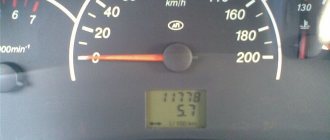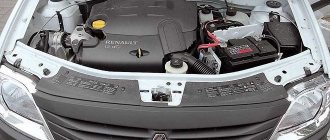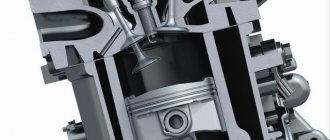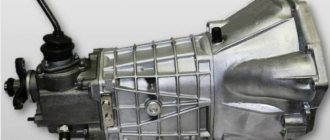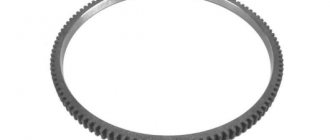The design of each car provides a special container - a fuel tank. Among its tasks is not only to provide the car with enough diesel fuel or gasoline for a long trip, but also to prevent fuel leaks and emissions of harmful substances. The tanks must be completely sealed, but depending on the car model they may differ in shape, material and volume. Moreover, the last characteristic is one of the main ones; you need to know it both to determine the cost of refueling and to plan a trip.
Types of fuel tanks and materials of manufacture
There is no single form and design of fuel storage tanks. To obtain the maximum volume of fuel tanks, their geometry is made complex - and different not only for individual brands, but also for each model. The containers differ in both material and equipment.
Main components of the gas tank
The list of equipment items differs for different vehicles. But most of them are universal and the same for all cars:
- Housing – steel, plastic or aluminum.
- The neck through which fuel is poured.
- A neck cover that may have a lock.
- An intake pipe, instead of which there may be a pump for pumping fuel.
- Sensor for monitoring fuel level.
- Tube and valve included in the ventilation system.
- Drain hole or pipe.
The standard set of equipment can be supplemented with other devices. Each model has its own list, which is described in the technical documentation for the vehicle. It is advisable for all car owners to study it in order to avoid mistakes when operating the car.
Design and principle of operation of the ventilation system
When considering the features of tanks of different cars, it is worth paying attention to the ventilation system, which solves several important problems:
- remove excess air from the tank during refueling;
- maintain the pressure at atmospheric pressure and avoid vacuum that could lead to tank deformation;
- maintain a safe temperature inside.
Most modern cars have a closed fuel tank ventilation system. The tanks do not have direct access to the atmosphere - a whole set of special devices are used to let air in. As the vacuum increases, the valve spring is pressed out. Air begins to enter inside until a pressure equal to atmospheric pressure is established inside.
Features of the design of fuel tanks in modern cars
Designers who design fuel tanks consider sealing first. No oil products should leak from the container and no evaporation should escape. Another important point is corrosion protection. You can avoid rust by using the following materials:
- high-quality steel, which is more often used on trucks;
- light alloys or aluminum, which can be found on passenger cars;
- polymers, thanks to which tanks of complex design are obtained.
Plastic tanks are considered the most convenient due to the complete absence of corrosion and lower weight. The disadvantage of plastic is its high permeability to gasoline and the likelihood of leaks. It can be compensated by using 2 layers of polymer.
EVAP system components
The main components of the fuel vapor recovery system are:
Fuel tank
Has some expansion room at the top to allow fuel to expand on a hot day without overfilling or leaking the EVAP system.
Fuel cap
Typically contains some type of relief valve for ventilation on older vehicles (pre-OBD II), but is completely enclosed (no vents) on newer vehicles (1996 and newer).
Gas tank separator
Located on top of the fuel tank or part of the expansion tank. This device prevents liquid gasoline from entering the adsorber.
Gas tank separatorLiquid gasoline should not be sent directly to the canister because this would quickly overload its ability to store fuel vapor. The separator is relatively problem-free. The only problems that can occur is that the fluid return becomes clogged with debris such as rust from the fuel tank.
Some separators use a slightly different approach to prevent liquid fuel from entering the canister vent line. A float is installed inside the separator. If liquid enters the device, the float rises and the valve closes the tank vent.
If there is a blockage in the separator or in the vent line between it and the adsorber, the fuel tank will not be able to “breathe” normally. Symptoms include fuel starvation or a warped fuel tank.
If you hear a significant "poof" sound when you open the gas cap, suspect poor ventilation. You can check the tank venting by opening the cap and then disconnecting the fuel tank vent line from the canister. If the system is clear of any blockages, you should be able to blow through the vent line into the fuel tank.
Blowing out with compressed air can sometimes clear the blockage. If not, you will have to inspect the vent line and possibly remove the fuel tank to diagnose the problem.
Ventilation valve
The ventilation valve controls the flow of outside air into and out of the adsorber. In some vehicles it is called the Canister Closing Valve (CCV).
One side of the ventilation valve is connected to the adsorber. The other side is connected to a ventilation hose that has a filter or mesh at the end and is attached to the body or frame of the car.
On some vehicles, the vent valve is attached to the canister. In others, it is installed separately.
Ventilation valve
The ventilation valve is controlled by the engine control unit. Normally the valve is open. It closes when the controller checks the EVAP system for leaks.
Adsorber (canister with coal)
This is a small round or rectangular plastic or steel container. It is usually hidden and may be located in a corner of the engine compartment or near the gas tank.
Adsorber FORD Focus
The adsorber is filled with approximately 0.5 - 1 kg of activated carbon. Coal acts like a sponge, absorbing and storing fuel vapors. The vapors are stored in the canister until the car starts, warms up and drives.
The ECU then opens the canister purge valve, which allows intake vacuum to pump fuel vapor into the engine. The coal container is connected to the fuel tank by a ventilation line.
Under normal conditions, the adsorber causes few problems. Since carbon does not wear out, it should last the entire life of the vehicle.
The most common problem with a charcoal canister is a faulty purge or vent valve. Vacuum purge valves can be tested by applying vacuum directly to the valve using a hand vacuum pump.
Adsorber VAZ
The valve should open and not allow vacuum to pass through if it is good. With solenoid type purge valves, voltage can be applied directly to the coil to see if the valve opens. The solenoid resistance can also be checked with a multimeter to see if there is an open or short.
The purge control strategy in many late model EVAP systems can be quite complex, so the best advice here is to look up EVAP diagnostic procedures in the manufacturer's service literature.
Why are the numbers in your passport not accurate?
The actual tank capacity is usually greater than the data in the car documents. Therefore, if the vehicle’s passport indicates 60-65 liters, the actual volume is 70-75 liters. Most car manufacturers add about 10-15%.
One of the reasons for the differences due to which the figures in the passport are inaccurate is the need for a reserve to compensate for the expansion of the fuel as the temperature changes. The pressure inside the container does not increase, and fuel does not leak out. The second reason is protection against fuel leaks when the car, and therefore the tank, is tilted.
Fuel distribution
Each engine has individual internal filtration protection. Special meshes are installed on the fuel intakes in the consumable compartments.
If all fuel priming pumps fail, engines can operate normally, subject to certain height and maneuvering load restrictions. These limitations are defined in the Flight Manual.
In cruising flight mode, if all fuel pumps fail, or the power supply to the onboard AC and DC electrical systems is turned off at the same time, fuel supply to the engine is provided by gravity from the wing fuel tanks, while fuel from the central tank ceases to be produced. During flight under the influence of negative overloads, stable operation of the engines is ensured for 10 seconds with a fuel consumption of 1700 kg/hour per engine. In gravity mode, in wing compartment No. 1, due to its lower bottom, there may be an unused fuel balance of up to 420 kg.
What are the tank sizes?
The average gas tank volume corresponds to the type of car:
- for small cars the value is in the range of 30-40 liters;
- for medium passenger cars – 50-80 l;
- for small trucks - 90-160 l;
- for trucks like KAMAZ - about 350 liters.
Based on the working volume of the fuel storage tank, you can find out how far the car can travel after full refueling. Although for this you will also need to know the engine parameters and take into account the driving mode - city, highway, combined.
Logan 1.6 MT 2008–present. 1st generation van
| Combined fuel consumption (l/100 km) | 8.1 |
| Tank volume (l) | 50 |
| Fuel consumption on the highway (l/100 km) | 6.5 |
| City average (l/100 km) | eleven |
| Environmental standard | EURO III |
| Acceleration time to 100 km/h (sec) | 13,4 |
| Maximum speed (km/h) | 167 |
| Recommended fuel | AI-95 |
Fuel tanks of passenger cars
Passenger vehicles have an average tank capacity of about 50 liters. Although, for example, three similar cars, Lada Vesta, Kia Rio and Hyundai Solaris, received tanks of different capacities. The domestic model has 55 liters of fuel in the tank, and 43 liters for both foreign cars.
A larger car, which also belongs to a passenger car, can be equipped with a tank with a capacity of 64 liters. And the Toyota Land Cruiser SUV, which can consume both 15 and 20 liters of gasoline - even with a 93-liter tank.
Refueling
Centralized refueling is carried out through a standard fitting installed on the right leading edge of the wing to refuel the aircraft with fuel under pressure up to 350 kPa (3.5 kgf/cm2) with a maximum flow rate of up to 1000 l/min. The duration of a full tank refueling is approximately 16 minutes for LR and B model aircraft. Centralized refueling is carried out automatically or manually.
The process of refueling or its termination is carried out automatically based on signals from the fuel quantity calculation unit (FQIC), when a specified amount of fuel is reached, or from the maximum permissible level indicators in each tank. In manual mode, the amount of fuel is controlled by signals from the tanker's meter and fuel meter; when the required amount of fuel is reached, refueling must be stopped manually; If the maximum permissible amount of fuel is reached, refueling stops automatically.
If fuel enters the drain tank during refueling, refueling is automatically stopped. To pump out fuel that has entered the drain tanks, jet pumps are used, which begin pumping after turning on the main pumping pumps.
Non-centralized refueling.
To ensure non-centralized filling (filling by level), two auxiliary filling fittings are installed in the left and right consoles between ribs 3 and 4 on the access hatch. Each of the fittings communicates directly with the corresponding compartment No. 3.
- fuel system discussion
- About SSJ and An-148 fuel meters - comparison and discussion
(published by: skydiver000)
Read more
page 1 of 81…next »
Random articles
Use of site materials is permitted only if a link is placed on superjet100.info
Truck tank capacities
Determining how many liters of fuel fits in a truck's tank is more difficult. There are not even approximate standards for such cars. For example, for different modifications of a KAMAZ vehicle, the volume is in the range of 175-500 liters. The average value is 350 l. But there are modifications with 600-liter tanks.
Large trucks like SCANIA 113 also have spacious tanks - 300-500 liters. The DAF XF truck is equipped with an 870 liter tank. And the MAN F90 with a load capacity of up to 48 tons has a tank capacity of up to 1260 liters.
Vehicle Features
Like any other car, Renault Logan has a number of features. Here are some of them:
- Convenient dashboard. Once you get used to this toolbar, there seems to be nothing more attractive than Logan's arrangement of indicators, indicators and buttons.
- Large volume trunk.
- The metal from which the Renault Logan is made is light and thin. This quality can be attributed to both advantages and disadvantages. If the car gets hit by hail, it will immediately affect the body, but the car is light and well balanced.
- Soft and sensitive gear shifting. Shifting gears is easy and the car's steam is sensitive and responds quickly to incoming commands.
- The car's chassis is reliable and suitable not only for European roads. The car was tested in the most difficult off-road conditions.
- Logan is equipped with two live French engines of 1.4 and 1.6 liters. Both engines work like clockwork.
- Electronics and lighting technology are on par with Japanese cars.
- Large fuel tank. The volume of the tank causes confusion among drivers who fill it up.
It is worth dwelling on the last point.
How to determine the real volume yourself
You need to know the approximate (with an accuracy of about a liter) volume of the fuel tank so as not to encounter underfilling at a gas station. Or that when refueling, the meter will show a larger number than what actually fits in a tank of that size. There are many ways to determine capacity - from the use of traditional methods to calculations.
Folk tricks
There are no instruments to measure such an indicator. But on automotive forums you can find advice on determining volumes. Among them is rocking the car to evaluate the sound from the splash and even weighing the car and comparing it with the passport data.
One of the fairly simple and accurate, but not too fast options is to drain the fuel, measure its volume and fill it back. But there are methods that allow you to determine the volume faster and more accurately. For example, using the dashboard.
By instruments
If the fuel indicator is in good condition, you can do without calculations and navigate only by instruments. For example, if the analog scale is divided into 10 divisions, and the approximate volume of the tank is 50 liters (according to the passport data), then each mark indicates 5 liters of capacity. This can be checked by filling the car with 5 liters and checking the change in the instrument readings. If after refueling the needle has moved not by 1 division, but more or less, the volume is recalculated.
The method will be relatively accurate if the machine is standing on a completely horizontal platform. In addition, it is not always possible to find out the maximum usable volume with its help - the last division of the scale usually coincides with the numbers on the passport.
Using diagnostic mode
Another method is only suitable for cars with a Renault dashboard. It is installed on all cars of this brand and some Nissan models. To start diagnostics, perform the following steps:
- Before starting the engine, hold down the mileage reset button for the last 24 hours for 5 seconds.
- Turn on the ignition and release the button when the instrument arrows continue to move.
- Using the same button, switch the diagnostic mode by selecting the icon with the image of a gas pump.
The method allows you to determine not the volume of the tank, but the amount of remaining gasoline or diesel fuel. The tank capacity will be known when it is full. The initial figure is added to the volume of fuel filled.
With sensor
In the absence of special dashboard modes, the amount of gasoline or diesel fuel can be determined using a sensor. It is installed directly into the tank and connects to the control device wirelessly.
This type of device is battery operated and lasts for at least 5 years. With its help, during the operation of the car, you can find out quite accurately how much fuel is left. And when the tank is full, the volume of the tank with an error is less than 1 liter.
Purpose
As the name of the part suggests, it is designed to store fuel. Thanks to this, the car is able to cover long distances. In addition to this main purpose, the gas tank provides the following functions:
- Prevents fuel vapors from entering the environment. This allows the vehicle to meet high environmental standards. Plus, near a modern car, even when fully refueled, you can’t smell gasoline.
- Prevents fuel leakage during vehicle operation.
This tank is designed so that the car can travel about 500 kilometers. Since each engine has its own fuel consumption, the size of the gas tank will be adjusted to this parameter. Compared to a gasoline powertrain, a diesel uses significantly less fuel (we'll explain why this is so here), so it can have a smaller tank.
Logan 1.5 dCi MT 2013–present. 2nd generation sedan
| Combined fuel consumption (l/100 km) | 4.5 |
| Tank volume (l) | 50 |
| Fuel consumption on the highway (l/100 km) | 4.1 |
| City average (l/100 km) | 5,3 |
| Environmental standard | EURO IV |
| Acceleration time to 100 km/h (sec) | 14,5 |
| Maximum speed (km/h) | 168 |
| Recommended fuel | D.T. |
Logan 1.4 MT Expression (2013) 2009–present. 1st generation sedan
| Combined fuel consumption (l/100 km) | 6.9 |
| Tank volume (l) | 50 |
| Fuel consumption on the highway (l/100 km) | 5.5 |
| City average (l/100 km) | 9,4 |
| Environmental standard | EURO IV |
| Acceleration time to 100 km/h (sec) | 13 |
| Maximum speed (km/h) | 162 |
| Recommended fuel | AI-92 |
Level control sensor
This sensor is found in all tanks and is part of the fuel pump. If the gasoline level decreases, the float moves lower. This entails a change in the resistance of the potentiometer associated with the float. As a result, the voltage in the electrical network drops, and the arrow on the dashboard displays the change. This way the driver sees how much gasoline is left in the tank.
Logan 1.6 AT Prestige (2012) 2009–present. 1st generation sedan
| Combined fuel consumption (l/100 km) | 8,4 |
| Tank volume (l) | 50 |
| Fuel consumption on the highway (l/100 km) | 6,7 |
| City average (l/100 km) | 11,8 |
| Environmental standard | EURO IV |
| Acceleration time to 100 km/h (sec) | 11,7 |
| Maximum speed (km/h) | 175 |
| Recommended fuel | AI-92 |
Logan 1.4 MT Authentique (2013) 2009–present. 1st generation sedan
| Combined fuel consumption (l/100 km) | 6.9 |
| Tank volume (l) | 50 |
| Fuel consumption on the highway (l/100 km) | 5.5 |
| City average (l/100 km) | 9,4 |
| Environmental standard | EURO IV |
| Acceleration time to 100 km/h (sec) | 13 |
| Maximum speed (km/h) | 162 |
| Recommended fuel | AI-92 |
Logan 1.2 MT 2013–present 2nd generation sedan
| Combined fuel consumption (l/100 km) | 6.2 |
| Tank volume (l) | 50 |
| Fuel consumption on the highway (l/100 km) | 5.2 |
| City average (l/100 km) | 7,8 |
| Environmental standard | EURO IV |
| Acceleration time to 100 km/h (sec) | 14,5 |
| Maximum speed (km/h) | 156 |
| Recommended fuel | AI-95 |
Logan 1.4 MT Expression (2012) 2009–present. 1st generation sedan
| Combined fuel consumption (l/100 km) | 6.9 |
| Tank volume (l) | 50 |
| Fuel consumption on the highway (l/100 km) | 5.5 |
| City average (l/100 km) | 9,4 |
| Environmental standard | EURO IV |
| Acceleration time to 100 km/h (sec) | 13 |
| Maximum speed (km/h) | 162 |
| Recommended fuel | AI-92 |
Logan 1.5 dCi MT – new century 1st generation MCV station wagon
| Combined fuel consumption (l/100 km) | 5,3 |
| Tank volume (l) | 50 |
| Fuel consumption on the highway (l/100 km) | 4.8 |
| City average (l/100 km) | 6.2 |
| Environmental standard | EURO IV |
| Acceleration time to 100 km/h (sec) | 18 |
| Maximum speed (km/h) | 150 |
| Recommended fuel | D.T. |
Logan 1.6 AT Expression (2012) 2009–present. 1st generation sedan
| Combined fuel consumption (l/100 km) | 8,4 |
| Tank volume (l) | 50 |
| Fuel consumption on the highway (l/100 km) | 6,7 |
| City average (l/100 km) | 11,8 |
| Environmental standard | EURO IV |
| Acceleration time to 100 km/h (sec) | 11,7 |
| Maximum speed (km/h) | 175 |
| Recommended fuel | AI-92 |
